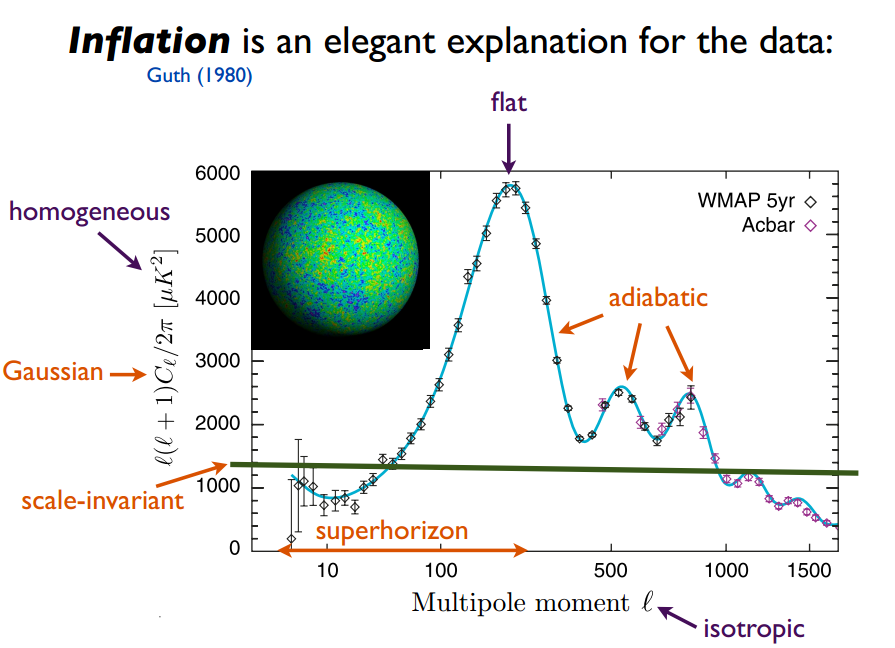Gravity, Flatness and Horizon Problems
This may depend on which model you prefer, but most cyclic models solve the gravity and flatness problems by saying the Big-Bang was powered by the energy from the previous Universe (e.g. Loop-Quantum Cosmology says the Big-Bang was powered by recoil from the previous contracting Universe, and Conformal Cyclic Cosmology says it was powered from left over gravitational radiation). Also, recent models have proposed that the rapid expansion of the current Universe is not fueled by inflation, but by a hypothetical energy called "dark energy".
This also avoids the horizon problem by saying that the Universe expanded beforehand, and then (usually in most models) contracted, leading to the information to come into contact with each other and the similarities to be preserved for the next Big-Bang.
This also avoids the horizon problem by saying that the Universe expanded beforehand, and then (usually in most models) contracted, leading to the information to come into contact with each other and the similarities to be preserved for the next Big-Bang.
Magnetic-Monopole Problem
Most cyclic models simply avoid this by saying making sure the temperature at the Big-Bang is lower than that needed to create magnetic monopoles. So although magnetic monopoles are possible, they aren't created.
Some cyclic models, such as the Steinhardt-Turok Model, predict a blue-colored gravitational wave spectrum (due to the Universe eventually contracting to a near-singularity), although this hasn't been detected.
Some cyclic models, such as the Steinhardt-Turok Model, predict a blue-colored gravitational wave spectrum (due to the Universe eventually contracting to a near-singularity), although this hasn't been detected.
Other
In 2010, British mathematical physicist Sir Roger Penrose said in a paper that anomalies in the CMB found by the WMAP satellite were confirmation of a prediction of Conformal Cyclic Cosmology.
Problems
The technique used by Penrose to determine the statistical-significance of his anomalies (whether they were real evidence or just co-incidence) was not based on the standard Lambda-CMB model... but on an undocumented, non-standard approach. So this evidence has been questioned.
The predictions made by cyclic cosmology are largely untestable at this point and therefore it lacks any serious data. Also, if the BICEP2 results are correct, it would mean that the previous predictions of the Paul-Steinhardt Model (that the gravitational waves would be too weak to detect in the CMB) are inconsistent with observation and thus that model would be unlikely.
The main problem though that plagued earlier cyclic models (originally known as "oscillatory" models) was the "entropy" problem.
The predictions made by cyclic cosmology are largely untestable at this point and therefore it lacks any serious data. Also, if the BICEP2 results are correct, it would mean that the previous predictions of the Paul-Steinhardt Model (that the gravitational waves would be too weak to detect in the CMB) are inconsistent with observation and thus that model would be unlikely.
The main problem though that plagued earlier cyclic models (originally known as "oscillatory" models) was the "entropy" problem.
The 2nd Law of Thermodynamics says that, in a closed system, energy is distributed over time and tends towards disorder (this tendency to go from order to disorder is called "entropy"). For example, heat and energy has spread since the Big-Bang and the Universe has evolved from an ordered, even, low-entropy past to a high-entropy, uneven present filled with galaxies and other structures. Applying this law to the Universe, it was realised there was a problem with the cyclic model, which goes like this:
- Entropy can only increase with each cycle.
- Logically-speaking, if you go back in time, then the entropy was lower.
- If entropy continues to get lower the more you go back, it seems the entropy was originally 0.
- It is impossible to have less than 0 entropy.
- Therefore, you can't have eternal Big-Bangs and the cyclic model is seriously flawed.
More recent models have their own approach towards this problem, as we have seen in the previous article Cyclic Universe: Big-Bang ad infinitum.
Acknowledgements
I would, once again, like to thank Hasan Mohammad for co-authoring this article. You can read his own science-related blog here: http://hasansthoughts.blogspot.com.au/











